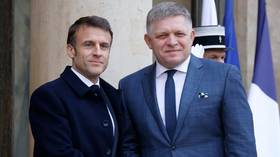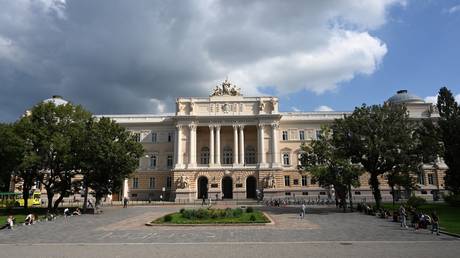Ukraine’s IMF Gold and the Gold Carry Trade
by Steve Brown, The Duran:

Let’s first consider a typical International Monetary Fund (IMF) loan to a sovereign in trouble, and then examine a typical gold carry trade transaction to support a sovereign arms deal. The intent is to demonstrate the importance of physical sovereign gold holdings in all forms of international trade.
Semi-failed and failed states can only exist by dealing in hard assets of real intrinsic value just as Syria, Venezuela, Iran, and Ukraine have done… and the most liquid of those hard assets is their physical gold.
Central Banks always work with the Security State apparatus when dealing with failed states and recall that the US Central Intelligence Agency funded al Qaeda and funded the war in Syria for example. Just about anything can be made to happen with funding when that funding is based on real resources. One of the most important of those resources is physical gold.
IMF Cartel Example: Ukraine
The IMF’s 2014 aid to Ukraine is based on a unique history however all IMF ‘aid’ packages are in some sense unique. Since we are highlighting the largely hitherto concealed importance of real physical gold in geo-political calculations and operations, Ukraine provides a relevant and timely example of how the banking Cartel operates with gold and may highlight that importance.
According to the 2018 Independent Transparency Index, Ukraine ranks as one of the most corrupt nations in the world. Ukraine ranks 120th out of 180 countries where the 180th – Somalia – is the most corrupt. But all nations need funding whether corrupt or not, and Ukraine defaulted on its IMF debt in 2001 and then again in 2009 when distribution of an existing IMF loan to Ukraine was frozen.
So, in 2014 why would the IMF strike another “deal” with a nation as corrupt as Ukraine for a whopping $17.5 Bn USD extended funding facility, when it had already defaulted on its previous two IMF loans? The answer lies well beyond the natural gas tariffs paid by Ukraine to the European Union and is founded in gold and state resources as well as geopolitics.
Consider Yanukovych’s attempt to confront the IMF and EU on its new onerous terms to settle Ukraine’s debt to the IMF in 2013, when Yanukovych and Mykola Azarov (then-Ukrainian Prime Minister) protested the IMF’s outrageous imposition of a 40% tariff on natural gas exported from the Ukraine (via the Russian Federation) to Europe. Yanukovych’s IMF ire was all US State needed to impose its will: Ukraine must cooperate with the IMF or take the consequences. Azarov and Yanukovych did risk the consequences and the entire corrupt Ukraine apparatus came tumbling down by February of 2014.
Nevertheless, Washington is aware that replacing one corrupt regime with its own will not pay that failed state’s bills, and Washington does not provide its own funds to the failed states that it creates. After all, that’s not how the Great Game is played. This is not about largesse, it’s about Washington demanding the spoils of war.
Thus in 2014 when Russia diverted its natural gas deliveries to bypass the troubled mess that Washington invoked in Ukraine, Ukraine urgently needed an International Monetary Fund bail-out. The IMF’s “round heels” did not come into play this time however – the IMF demanded a solid ‘guarantee’* for its first installment of funding to Ukraine.
One IMF demand was for Ukraine to setup its own National Anti-Corruption Bureau as a ceremonial gesture, since Ukraine’s deep corruption is endemic, extant, and simply an accepted way of life there.
The other demand was for Ukraine to partly collateralize its IMF loan with gold reserves. We know that because the IMF tells us so: (The IMF) may accept gold in the discharge of a member country’s obligations (loan repayment) at an agreed price, based on market prices at the time of acceptance.
And we can prove the IMF-Ukraine 2014 gold transaction by simply looking at the historic fluctuation in Ukraine gold reserves. In October of 2014 – just nine months subsequent to the Maidan coup – Ukraine reduced its gold reserves by fourteen tonnes (metric = 2200 lb per tonne). Fourteen metric tonnes of Ukraine gold were flown to one of the designated IMF gold depositories: Gold depositories of the Fund shall be established in the United States, the United Kingdom, France, and India as noted by the IMF itself.
But why did the IMF require just fourteen tonnes of the Ukraine’s gold as a loan guarantee? Let’s look at the figures. Fourteen tonnes of gold equates to 30,800 lbs, or 492,800 ounces. At 400 oz per bar 1,232 bars of gold were flown from the Ukraine to the IMF designated depository. At then-prevailing market price — note that the US government still values gold at only $42 per ounce! — Ukraine’s gold provided $640M US dollars’ worth of loan collateral to the IMF.
In sovereign terms, a $640 million guarantee seems trivial. But recall that most aid guarantees are fractionalized at 10%, meaning that Ukraine needed just that much in collateral to finance its first tranche loan from the IMF of $5 Bn USD as received from the IMF in 2015. Ukraine provides just one example regarding the IMF’s extortion of sovereign gold from the failed states it hopes to service.
But gold is not the only important asset a nation can trade in exchange for its debt, the IMF demands much more than a fractionalized gold pay-off as the people of Greece have discovered. Oleksiy Honcharuk the current embattled Ukraine Prime Minister, just announced that Ukraine expects to receive $500M USD from the IMF in exchange for the sale of Ukraine state-owned firms to private buyers.
The point however is that gold has always been an important asset in world trade regardless of those who claim otherwise. And it is just as important now – perhaps more so – than it has ever been; note that states like Burundi, the United Arab Emirates, and Iraq have dramatically increased their gold reserves. And at least the IMF admits to trading in sovereign gold while the US Federal Reserve only admits to trading in gold while actively denying that fact! (See link)
Gold Carry Trade Arms Deal
Note that the physical gold in this example trade does not move outside of its vault in New York, London, Paris or whichever bullion bank is holding the bars. That’s because the vaults in London, New York, or Switzerland are designated by numbered accounts and those numbered accounts (assigned to a particular vault or to particular group of bars) may alter over time by transaction, but the 400 oz gold bars are seldom transported; only the account numbers and allocated bars in the individual (and many) bullion bank vaults may change. There are rare exceptions when the gold does move – for example when Venezuela physically repatriated its gold from New York.
The usual classic carry trade is when a sovereign or primary bank simply leases gold from a London Bullion Market Association bank, sells the gold to convert to higher yielding assets, then re-purchases the gold at the end of the lease period to satisfy the lease. The sovereign or dealer will provide security for the transaction (perhaps a percentage of its own gold reserves or other state assets) and pay what is called the Gold Forward interest rate (GOFO is usually 1%) to the bullion bank and return the carry trade gold by re-purchase at then-prevailing gold market prices at the end of the lease.
Central Banks operate the same way, utilizing the same type carry transactions but generally only to support or debase their currency or another currency. (Central Banks also hope that semi-failed states will sell their gold reserves to Central Banks at knock-down prices as Syria did in 2012!)
But the hypothetical scenario below is a different type of carry trade. The example below contests the commonly held premise that belligerents are freely ‘given’ their arms by the major powers. In very unreliable circumstances like Somalia, Sudan, Yemen, and formerly in Eretria etc – the ‘free delivery’ of weaponry by major powers for political reasons is partly true. And in Libya, the Sahel states inherited weaponry after the assassination of Qadaffi.
The idea here is to show the importance of the gold carry trade to Central Banks and their related security state in the provision of arms to failed states by way of collateral and special bank accounting. The carry trade is the financial trade of choice for Central Banks when dealing with failed or semi-failed states, because the gold carry trade provides all parties:
- Absolute Secrecy
- Zero public accountability
- Zero legislative accountability
- 100% political cover
- Guaranteed profits, and perhaps even the
- Spoils of war or
- Financial collapse to profit Central Banks
- No limit on the amount of GOFO gold leased**
- Zero risk based on Central Bank accounting
In this typical but hypothetical carry trade arms deal, the Central Bank (called by the fictional name “CBBI”) hopes to identify a semi-failed or failed state possessing either its own gold reserves or mining resources so that the Central Bank may gain leverage and perhaps state-owned resources too, or even intervene militarily by proxy, by way of a carry trade for arms. Mali springs to mind as one potential current example as does the pending new independent state of Bougainville.
Loading...



